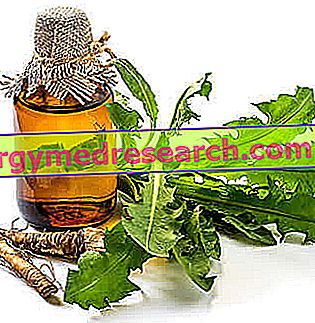Water retention
Water makes up the majority of body weight. It is not only present in the blood, but also in the muscles, organs and even bones. The extracellular and intracellular spaces are full of water, with some small exceptions in which fats seem to prevail (adipose, nervous tissue, etc.).
What is water retention?

Water retention as a blemish is more frequent in people with difficulties in the blood and / or lymphatic circulation (however normal), particularly in the venous return of the lower limbs. In addition to genetically predisposed subjects, women, the sedentary (in particular, who spend a lot of time sitting), those who stay for long periods standing up and those with hormonal irregularities are more at risk.
Illness and / or blemish
Water retention is often unjustly blamed by someone who, for one reason or another, fails to lose weight; in most cases it is a "scapegoat". If the weight does not drop almost certainly it is not because of water retention. The rolls that are clearly visible in the waistline must therefore be eliminated by thinning the adipose tissue, due to an increase in energy consumption and a reduction in calories; water retention has nothing to do with it!
Water retention and cellulite
The speech changes, at least in part, in the case of cellulite (panniculopatia edemato sclerotica fibro); this blemish, too often "disguised" as a disease, is closely related to water retention and to the complications (even non pathological) of the lymphatic and venous circulation. Especially in female subjects, adult or old age and overweight, with prevalence in the lower limbs on the rest of the body, the first stages of cellulite are closely correlated with water retention.
Water retention, caused mainly by capillary complications, discomfort of venous return and lymphatic insufficiency, is the basis of the process of cellulite formation (visible with the orange peel effect). However, if limited to these imperfections, the extra water does not significantly affect the weight, even if the lifestyle adjustments necessary to fight it often cause a significant and measurable weight loss.
Let's see how we can intervene in the diet to combat water retention.
Diet
What to change in the diet to reduce water retention?
We begin by specifying that to combat water retention, it is NOT necessary to decrease the intake of liquids. For clarity, we also specify that there are NO miraculous foods, beverages or supplements. Too often we fall prey to commercial "fishing" and media influence and, despite we are aware that certain effects are completely impossible (cit .: "water that eliminates water"), hope is always the last to to die.
Dietary sodium and water retention
Sodium is a mineral necessary for the health and survival of every individual. This cation plays an important role in regulating blood pressure and extra cellular fluids. The sodium requirement varies greatly with sweating; those who sweat a lot, especially in sports and in the summer, if they do not use table salt (sodium chloride) to flavor food, they risk incurring a slight deficiency (increased muscle cramps, low blood pressure, etc.).
Already present in an almost ubiquitous way in food, in the western diet sodium is used for different preparations and added (discretionary sodium) to dishes. Table salt, the main source of sodium, contains 40% of this macroelement. For this reason it is often present in excess, with sometimes undesirable consequences (eg pathological increase in blood pressure).
For many years it has been hypothesized that the excess of sodium, accumulating in the extracellular compartments, may trigger or aggravate water retention. Suggesting to control sodium levels in food and beverages, it has therefore contributed to spreading half the truth. Let me be clear, reducing sodium in the Western diet can only benefit the health of the population. However, the excess of the mineral is easily compensated by the renal filtration system, the main way of eliminating the undesirable compounds circulating in the blood. That is why it is not said that reducing the sodium in the diet can get great results in the fight against water retention.
Dietary potassium and water retention
Potassium (K +) is another essential mineral. This other cation also plays an important role in regulating blood pressure but, unlike sodium, it modulates intra-cellular fluids. On a metabolic level, potassium has an almost opposite function to sodium.
It is no coincidence that this macroelement is also responsible for the so-called "thirst quenching" effect; at the same time, the richness in potassium conveys to the palate a sensation similar to sapidity, favoring the reduction of discretionary sodium. Although neither can be considered a "bad" nutrient, potassium can counteract the side effects of excess sodium. For this reason, it is believed that the richness of potassium is a fundamental requirement for the diet against water retention. Like the previous one, the need for potassium varies greatly with sweating, but on the contrary it cannot be integrated as easily; potassium is mainly found in vegetables and fruit, but also in meat and fish.
With regard to its effectiveness, however, the same argument made for sodium holds true even if, in an objective manner, it could be argued that IF the two minerals had a significant impact on water retention, this would be expressed at the most by associating the reduction of the first to the increase in the second nutrient in the diet (K +).
Water in the diet and water retention
We do not spend words on the importance of water for health and we begin by emphasizing that it is the diuretic nutritional factor par excellence. At the beginning of the article we specified that water retention is caused by a stagnation of extracellular fluids, which in turn is potentially caused by impaired blood and lymphatic circulation. This amorphous liquid tends to absorb elements of various kinds, such as ions and other molecules, becoming increasingly difficult to reabsorb. Based on this principle, by exploiting our "natural filters", that is the kidneys, increasing the diuretic effect we also increase renal function and efficiency in disposing of unwanted molecules. After having urged the peripheral reabsorption of water retention (effect on circulation), increasing the diuresis we can also facilitate the excretion of unwanted or excess molecules. However, as can be deduced, if the venous return, the lymphatic circulation and the capillary action are at fault, this arrangement is completely useless.
Drainage in the diet for water retention
They are all those foods of plant origin that, for one reason or another, increase the drainage of liquids from the stagnation compartments to the bloodstream and from here, through the kidneys, to the urine.
Diuretics are draining: dandelion, artichoke, fennel, endive, chicory, cucumber, pineapple, melon, watermelon, peaches, strawberries etc.
In the herbalist field, different plants with draining power are also known. For more information see the dedicated article.
Protective capillaries in the diet for water retention
Many plants have protective phytotherapic properties on the capillary walls; reinforcing them, these improve the circulation also preventing varicose veins and cellulite. They are particularly known for their efficacy: blueberry, melilot, centella, butcher's broom and horse chestnut.
Vasodilators in the diet for water retention
The only nutrients that have a desirable vasodilating effect are the omega 3. Alpha linolenic acid, but above all eicosapentaenoic and docosahexaenoic, increase the vasal section by promoting blood circulation. Furthermore, they make the blood more fluid and less viscous.
Alpha linolenic acid is typically of vegetable origin, from cold-pressed seed oils (such as chia, perilla, flax, etc.); Eicosapentaenoic acid and docosahexaenoic acid, on the other hand, are mainly found in sea fish of the cold seas or in the blue one, and in their liver.
Sport
Motor activity: reduces water retention?
Of course yes; it is perhaps one of the few systems that are truly effective and independent of other factors against water retention.
Increasing motor activity induces vasodilation, increased blood circulation, oxygenation of normally less perfused tissues, pumping of venous blood from the lower limbs towards the heart, etc. All this allows an improvement in the reabsorption of peripheral fluids and a decrease in stasis that causes water retention.
Many have tried to show that some activities have a more significant effect than others or that even certain sports aggravate water retention. They are often blamed: the production of lactic acid, considered responsible for an osmotic effect on the tissues, the effect of gravity and rebounds on the lower limbs in the bottom run and in fast walking. In both cases these are real distortions. Physical activity is always beneficial for water retention in healthy subjects. The effect of swelling is instead caused by transient pumping, greater in the activities of musculation that produce lactic acid; lactic acid has nothing to do, in fact this gap of anaerobic glycolysis is readily re-elaborated by the liver (usually within a couple of hours) and does not stagnate in any compartment of the body.
Lifestyle
Habits, work and leisure: how do they affect water retention?
Habits, work and how to spend your free time have a great influence on water retention.
At this point it is now clear that the position of the body, in relation to the time spent in it, can increase or decrease the venous return, lymphatic drainage and microcirculation. This explains why people who work in a sitting position (for example, employees) are more likely to suffer from water retention. The angles formed by the joints of the legs and the application of weight on the thighs compromise the flow and promote stasis. In the same way, those who remain standing for long periods (for example the assembly line workers, kitchen technicians, etc.) must deal with the force of gravity, which certainly does not facilitate the flow from the feet towards the heart. The ideal activity, on the other hand, is the mixed, dynamic one, which does not allow one to remain immobile for long. The same concept can be applied to recreational leisure activities; people without interests or passionate about sedentary hobbies will always have a greater tendency to water retention than those who, on the contrary, enjoy hiking, hunting, gathering, gardening, etc.
A word should also be spent on clothing, which is often governed by chaos. Sturdy clothing and tight clothing are NOT the same thing. There are garments designed to facilitate resorption, restraining precisely, which exerting constant and uniform pressure and can therefore improve water retention. On the other hand, very tight trousers (especially jeans), "hanged" belts, high boots, etc. tend to tighten the thigh (in the groin) and the leg (just below the knee) in the wrong places, creating a "constriction" in the vessels and worsening water retention.
It is important for women to note that physiological and fertility hormonal flows are responsible for water retention in some days before, during or after the menstrual cycle. This is physiological and must not be in any way countered. It is different if the large effect is induced by certain hormonal therapies; in this case it may be useful to talk to your doctor.
Pregnancy is responsible for a fairly marked water retention, but obviously it is only necessary to be patient until the time of delivery.
In any case, for those who at the end of the day feel a clear feeling of swelling in their legs, it may be advisable to lie down in a supine position, resting the lower limbs on a wall, creating an angle close to 45 °, thus facilitating venous return.
Other
Medications can increase water retention
Water retention is also a side effect of many drugs. In particular those:
- FANS painkillers such as ibuprofen, but especially cortisone steroids
- Antidepressants
- Chemotherapy.
If the water retention is excessive, besides not being able to be fought with the diet, it could need the reformulation of the responsible pharmacological therapy.
Pathologies responsible for water retention
The diseases responsible for water retention cannot be countered by diet. Among these we remember above all:
- Venous insufficiency
- Thrombosis
- Heart failure
- Pulmonary edema
- Lymph node disorders
- Cysts and other anatomic impairments.



